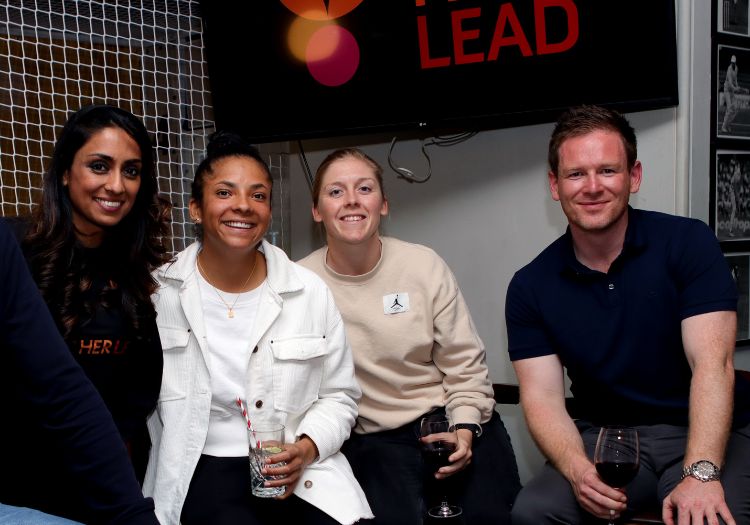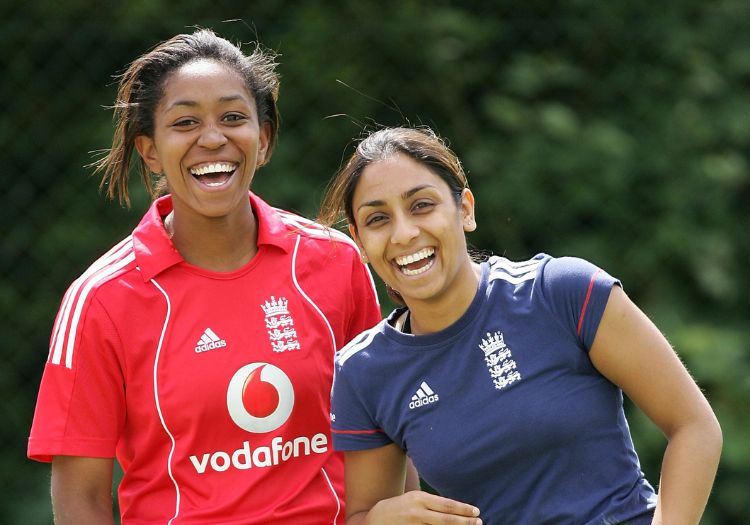NICK FRIEND: As Guha - the England bowler turned respected broadcaster - launches Take Her Lead, she sits down to talk through the impact of her mother, the shift in women's cricket since her retirement and why her foundation can make a difference


At the heart of Take Her Lead, Isa Guha's newly launched foundation, is a paradox.
Women's cricket is the sport's fastest-growing market but, through a summer of pilot programmes, it has become clear to the former England seamer that the game at grassroots level is lagging behind.
The initiative calls them mentors; in reality, though, the women brought in to lead sessions with more than 300 girls across the season-just-gone are a mixture of county players, domestic professionals and England stars. Their collective takeaway from returning to where they began their cricketing journeys is that less has changed than ought to be the case at the early stages of the pathway.
At the top end, progress has been undeniable: the scheme launched in the week of England's ODI defeat by India at Lord's, played out in front of a record crowd for a women's bilateral-series match in the United Kingdom, and a matter of days after the schedule for next year's Ashes series was given the same billing as the men's equivalent. "If you take that at face value there, it's easy to assume that the grassroots side has moved at such a pace," says Jayde Ellis, the founding chief executive of the organisation.
She isn't ignoring the contribution of the All Stars and Dynamos programmes, but what happens next – after a positive introduction to the game – is the question that often has come without an answer. "What happens when that exciting, big, bright colourful programme ends?" she asks. "Is the experience at the club just as good for that girl who transitions out of All Stars into the more traditional club structure?"
The truth varies from club to club, individual to individual, but wider issues – like the use of white kit – remain underdiscussed. Only last month did BBC Sport publish an article explaining why more needed to be done around the production of clothing and equipment for female cricketers. Another piece of feedback through Take Her Lead's first summer was around the conspicuous lack of statues depicting female cricketers, even if Lord's is now home to the Heyhoe Flint Gate.
Take Her Lead doesn't claim to have all the answers, but it promises to listen, to share its findings around cultivating a more inclusive environment and, with Guha at the forefront, to inspire a generation of young women using the memory of her late mother, Roma, who laid the foundations for a career that has long-since transcended 113 international caps and an England debut at 16. "One thing my mum was, she was very pragmatic and philosophical about life," says Guha, "that was probably attributed to the region she came from in India where they were big thinkers in Calcutta.

Isa Guha (left), with Sophia Dunkley, Heather Knight and Eoin Morgan at the launch of her foundation, Take Her Lead
"Life is what you make it, and I was very grateful that I had that time with that team where we went from being quite average to becoming the best team in the world."
So, there was never a grand plan to remain in the game once she'd finished – she has a degree in biochemistry from UCL – nor does she feel particularly comfortable with her own significance as a broadcaster and former athlete. "I recognise my responsibility as someone who is doing what I'm doing and has the ability to speak up when I need to," she says.
"Mum is the reason why I've started this. I've been inspired by other people who've done an amazing thing, and that's something that I constantly battle with.
"But I am in a position to be able to do this."
As Roma's daughter co-presented television coverage from Wimbledon earlier this year, it was impossible to escape the reality that many observers wouldn't even have known that they were listening to the first woman of Asian heritage to represent England and a multiple World Cup winner, so prominent a respected voice has she become since her international retirement a decade ago.
"It was a really hard decision to make at the time," Guha admits, "and I sweated over and I just didn't want to let anyone down. But ultimately, it was the right decision at that time for me. It's meant that I've been able to do something else and I want to experience everything that life has to offer, and I feel very grateful that I've been able to go into broadcast now and do what I do and still remain in the sport by being able to.
"At the start of that journey, there weren't a lot of women doing it. So, to now look around and go: 'Wow', we've got so many amazing female voices, it's become normalised. That's ultimately what excites me, being able to be part of change."
A major element of that change is in a game-wide mindset shift: Guha played for England in the pre-professional era, before central contracts, at a time when their kit – even at international level – was mostly hand-me-downs from the men's team. For context, she first represented her country three years before Katherine Brunt and, on her Test debut, was captained by Clare Connor, currently the ECB's interim chief executive. Mithali Raj, her first wicket in that game, had made her international bow in the 20th century. Not long before, England's players had to pay their way on tours abroad.

Guha and Ebony Rainford-Brent during their England playing days (Christopher Lee/Getty Images)
"I always look at inequalities as a journey," Guha reflects, "and you look at where you're at on that journey. So, I could look at women's cricket right now and say, well, we've moved this far in the last 20 years, and how amazing is it that we've now got 60 professional cricketers in this country. I wouldn't have imagined that when I finished playing. I wouldn't have imagined that we would have a professional team within four years. So, I'm truly grateful for that and I think it's important to be grateful.
"But I think quite a lot of the time, women are sort of made to feel that way and that's all and to never push themselves further than that for fear of losing their place in wherever they are. Not just in cricket but in the workplace, or wherever they are in life. So that's been drilled down over years, and years and years. So, right now, I look at the journey where it's at, but then I compare it to where the men and I go: 'Okay we've still got a long way to go.'
"So, that's generally my feeling. How do we push it forwards at this stage where we're at a real tipping point where you can't look away any longer? It's coming. Women and girls are inspired to want to play sport and showcase what they can do."
That attitude comes from Roma: "She was a teacher and she took a lot of pride out of helping to guide people towards their goals. She used to call it 'forwarding' people. But she had a particular impact on disadvantaged young people in the community, to give them confidence to believe that they could tackle anything and get out of their comfort zones.
"I think one of the biggest things was that she believed in humanity, and was always super-positive, and learnt about lots of different cultures so she could create an inclusive environment wherever she went. That's the philosophy that we want to take into what we're trying to achieve here, which is having that respect for people of all backgrounds, race, gender, ability, class, like everything.
"That respect comes from understanding that we don't know everything. We're trying to learn, and how can we be better? How can we ask the right questions to understand what the barriers are, and people feel comfortable to be able to speak up about their experiences?
"I've been inspired by these young women who are like nine, 10 and 11 who are talking about inequalities in the game already. They're so far advanced around what the issues are, and they have so much confidence around what they're speaking about as well.

Guha has become one of sport's most accomplished broadcasters since her retirement (Stu Forster/Getty Images)
"They're not fussed about talking about it like I probably was back in the day when I was probably shy or not as confident talking about what the issues have been in the game. Only later on in life have I built up that confidence from working in this space, and I then have felt more confident speaking up, but these young women are so aware and they have an incredible awareness of what's happening and how to channel that to then go: 'Right what are the solutions?'"
Guha has spoken to Tom Brown, whose research has been integral to the success of the ACE Programme and was at the core of the South Asian Cricket Academy (of which Guha is a patron), and credits Ebony Rainford-Brent with providing her with the confidence to take the leap of raising her own organisation. She also praises the work done by another former teammate, Lydia Greenway, with Cricket for Girls.
For the England-India ODI, they partnered with the MCC Foundation and Lord's Taverners, as well as bringing along 55 young girls through the Super 1s and Wicketz schemes – for the experience of being at Lord's, while the pilot edition was delivered by Sunrisers, the hub within the women's regional structure featuring nine counties.
The long-term objective is to be active nationwide. Because, ultimately, all these organisations have the same aims at heart: to make cricket a more welcoming place for everyone. Take Her Lead is merely raising its hand to play a part – to support rather than challenge. "We're all in this together," Guha adds.
"That's definitely who mum was and how I am as a person: how can we support everyone to kind of do this as a team? That's what led me to cricket in the first place."
Subscribe to The Cricketer for exclusive content every day: The inside track on England's Test tour with George Dobell in Pakistan, award-winning analysis, breaking news and interviews and the only place for in-depth county coverage all year round. Plus: An ad-free app experience at your fingertips. Subscribe to thecricketer.com today for just £1.
Posted by Lori Bedborough on 28/05/2023 at 11:31
This is so positive & vital for cricket. Good work ISA. Everyone should be made welcome into the cricket world. X